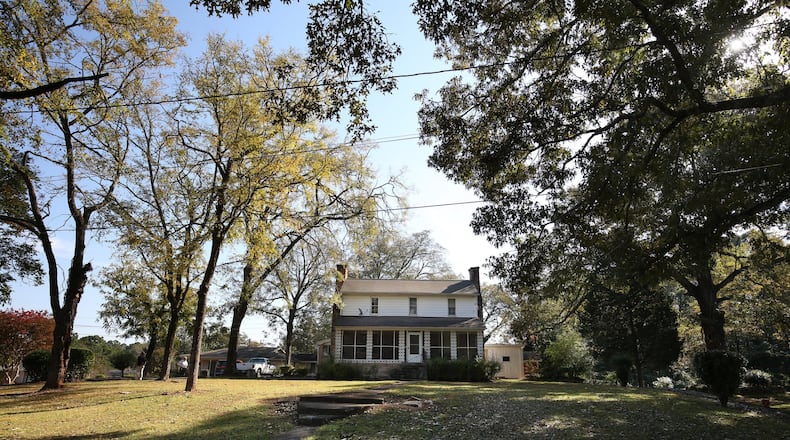The Big House has seen better days. Thomas Livsey, the unofficial mayor of these parts, admits he has too.
Not fond of walking or standing any more than necessary, he sits side-saddle in the driver’s seat of his champagne-colored Pontiac, ready to talk about things that were and things that might be. The house — for two centuries the hub of this southern tip of Gwinnett County known as The Promised Land — looms over his shoulder.
Livsey, now in his late 80s, was born in the white house that still bears many of the telltale characteristics of a plantation home. He was the 14th of 18 children born to a pair of proud black pioneers.
“There’s a lot of memories in there,” Livsey says.
And a lot of history, too. That's what drew Gwinnett County to the property, which it purchased in 2016 and is in the early stages of restoring. By using a combination of 19th-century documents, first-hand accounts and new-fangled technology, the county hopes to renovate the house and its surroundings to better preserve the stories that come with one of metro Atlanta's most uniquely historic homesteads.
The property went from being a slave-worked plantation to a place where descendants of those slaves could not only live and buy their own land, but survive and thrive — a sort of self-contained community in then-rural Georgia where black people could be educated, where they could become entrepreneurs and open businesses and build their own futures.
When the renovation of the house is finished, the county plans to open it up as a museum.
The Big House, as the Livseys came to call it, was built in 1825 by a white slave-owner and figured prominently in the research Margaret Mitchell did for “Gone With the Wind.” But it’s the Livsey family and what its members helped create that will be the focus of restoration efforts.
Thomas Livsey’s father, Robert, bought the house and about 100 surrounding acres in the early 1920s, using savings from his work with the railroad. That alone was not an insignificant feat for an African-American man in the Deep South. Part of what was once a 1,000-acre plantation was converted into a thriving farm and an important center of gravity for a burgeoning black community.
“You talk about an awesome historical site here in Gwinnett,” Catherine Long, the county’s cultural resources manager, said during a recent visit to the property. “You’re standing on it.”
‘The destruction of Jerusalem’
It was Thomas Maguire, an Irish immigrant, who dubbed the area The Promised Land in the early 1800s. He’d won a land lottery and, as the story goes, became rightfully smitten with the property. Over the years, he turned 250 acres between what are now Centerville and Lithonia into a sprawling, tree-lined plantation four times that size with Stone Mountain visible in the distance and the Yellow River running through.
Maguire, a devout Freemason and teacher of temperance, was commissioned as a captain of the local Rockbridge militia in 1828. An estimated 26 slaves — Isaac, Will, Betsey, Phillis and Carolina, just a few of them — eventually worked his plantation, which grew corn, cotton, wheat and number of other crops.
The Maguire home also functioned as a post office and a voting precinct.
“It stands today,” a man named John M. Harrison wrote in 1949, “though one wonders how it escaped the torch when Sherman passed.”
Maguire’s own farm journal — which Margaret Mitchell is said to have drawn significant inspiration from while writing “Gone With the Wind,” and which is helping Gwinnett re-discover the property’s past — provides few answers to that question.
Among more mundane entries like “hands shearing sheep” and “finished making children’s shoes,” Maguire details multiple encounters with Yankee and Confederate soldiers.
Gwinnett County was not home to any Civil War battles, but Atlanta was not too far in the distance — and effects of the conflict were certainly felt on the Maguire plantation.
In November 1864, the Yankees arrived in force. Having already sent their families away, Maguire and brother-in-law David Anderson hid out in the woods for days as soldiers took up residence in the house. They slaughtered his animals, ate his crops and burned everything but the main homeplace before moving on.
“The destruction of Jerusalem on a small scale,” Maguire wrote in his journal. He’d later pen “a list of property stolen by the Yankees from Thomas Maguire.”
It amounted to more than $40,000 and included “4 Negroes.”
Maguire would own the Big House at The Promised Land until 1886. Renters lived there for the subsequent 30-plus years — until descendants of slaves like those who worked Maguire’s fields began buying up the land.
Men with big hearts
Robert Livsey, who was born in Dacula, purchased 100 acre and Maguire’s former home in 1920, using $2,500 cash he’d saved up from his work with the railroad. His was among the first black families to own sizable property in the area.
The Livseys built a farm, raising many of the same crops Maguire had, everything from cotton and corn to fruit trees and syrup.
Thomas Livsey, then a child, laughs today when asked what life was like.
“We didn’t have Christmas every day,” he says. “We went to the field and worked.”
Other black families joined them, including Thomas Anderson, the son of slaves, and his wife, who opened the first African-American owned grocery store in the area in the 1930s.
Dwight Thomas, 67, is a prominent Atlanta-area attorney and the grandson of Thomas Anderson. He grew up spending weekends in The Promised Land with his grandparents.
“Mr. Livsey and my grandfather were both men who had big hearts,” Thomas says. “… My grandfather gave away more than he charged people.”
In a segregated South, the Promised Land and New Bethel AME Baptist Church eventually offered the only school for the community's black children. Others were too many miles away, either in DeKalb County or in Lawrenceville. Today, Anderson-Livsey Elementary School, named after the two pioneers, sits less than a quarter-mile from the Big House.
And while the Anderson and Livsey farms would produce for their families and the larger community for decades, it’s Thomas Livsey enterprising spirit that would later build The Promised Land back into a thriving center of black life.
As a young man, Thomas Livsey briefly left for Chicago and then the battlefields of Korea, but returned with a mission. Over the years, he would build a small empire in the area: 14 different homes for siblings and others, as well as a long list of businesses.
There was The Promised Land Grocery Store, which opened in 1970 on the corner of Lee Road and Anderson-Livsey Lane, a stone’s throw from the Big House. It still stands.
There was also a barbershop and a gas station and a car wash and a laundromat and a restaurant.
“It really became an African-American community thanks to the Livseys,” says Long, Gwinnett County’s cultural resources manager.
‘A legacy that needs to be maintained’
Two years ago, Gwinnett County purchased the Big House and about 1.5 acres of surrounding land from Thomas Livsey, who was still living there. The county paid about $160,000.
With an eye toward an upcoming bicentennial — Gwinnett turns 200 on Dec. 15 of this year — officials said they hoped to be able to share the rich history of a home that has nearly spanned the county’s entire existence.
But the site will be predominantly “interpreted” through the Livsey-era, says Long.
That will present an opportunity unlike any other in Gwinnett County, she says, because folks like Livsey are still around to talk about it.
“How were they using the landscape? Where was the cotton field, where was the cornfield?” Long says. “And because we have these oral histories and all this information we’re able to start plotting this. And that has never been done at any of our historical sites.”
Specialists are also already in the process of — quite literally — peeling back layers of construction at the Big House to determine what was done when, what should stay and what should go. They’ll be able to make a 3D model too.
The goal is to create a sort of interactive museum for school kids and the public. Heritage tourism, it’s called.
The final product is likely still a few years away. Livsey says he has 100-year-old furniture to contribute.
“To see them buy that and preserve that, that’s an improvement for Gwinnett County,” says Thomas. “And it maintains a legacy that needs to be maintained. … Everybody needs to know what it was and what it can be.”
Livsey has reasons both practical and sentimental to be glad the county purchased the home. He and his sister were trying to maintain it, and they’re both getting the opposite of younger.
And he wants generations beyond his children and theirs to know what happened here — at a time when the laws and customs were set up to stifle prosperity, equal access and independence of black people, The Promised Land offered a shot at milk and honey.
“I want them to fix it up and make it look pretty,” he chuckled. “And I’ve got about 50 or 60 Livseys wanting to come here to see it.”
A snapshot of rural Georgia in the early 20th century
- In 1920, Gwinnett County's population was just more than 30,000. Nearly 75 percent of Georgia's population was rural at the time.
- About 40 percent of Georgia's "farm operators" were black — but, on average, their farms were half the size of white counterparts.
- By the mid-1920s, the boll weevil had ravaged Georgia's cotton fields and further decreased small farmers' prospects for making a living.
- While some black people still owned their own farms in the 1920s, many were forced off their land entirely by declining prices and into menial jobs in towns and cities.
Sources: U.S. Census Bureau, New Georgia Encyclopedia
About the Author
The Latest
Featured









